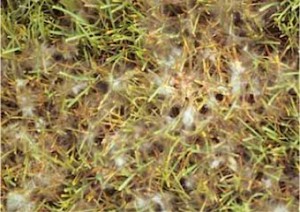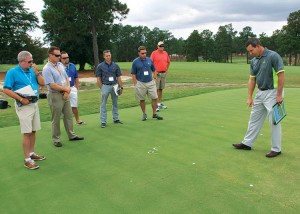Making fungicides work
“Performance of fungicides is determined by you and you alone,” says Jim Kerns, Ph.D., associate professor and extension specialist in plant pathology at North Carolina State University. “The products work.”

Dense Pythium aphanidermatum on tall fescue
lawn./Courtesy Penn State University Center for Turfgrass Science
Among the keys to successful disease control is getting an accurate diagnosis. “It matters not which lab you use but develop a relationship with that lab,” he advises. “A lab that gives you the name of a pathogen alone is not providing a diagnosis.” For that reason, “Pythium” is not a diagnosis.
Pathogens always are present in the soil. A disease is simply the plant’s reaction to that pathogen. No reaction, no disease.
That said, Kerns says fungicide rotation is critical to successful disease control. Time the application properly and select the best fungicide for your site. Put the fungicide where the pathogen is with uniform coverage of the target site, he says.
When it comes to topical mode of action, new fungicide chemistry is and will continue to be single-site products. “There will not be any new multi-site chemicals coming from labs,” he says.

“Performance of fungicides is determined by you and you alone,” says Jim Kerns, Ph.D., associate professor and extension specialist in plant pathology at North Carolina State University.
Although superintendents and other turf managers would love to have new versions of the traditional multi-site materials available, it just won’t happen given today’s economics.
“Turf is minor in the ag chemical world,” he says. “If a product can’t make it in wheat or corn, it is not coming to us in turf,” Kerns says.
The reason, he adds, is because turf managers remove applied material every time the grass is mowed. “How many times have you seen a wheat field get mowed?” he asks.
Knowing topical mode of action helps plan strategy. Contact materials do not enter the plant but stay on the cuticle. Localized penetrants are absorbed and pass through the leaf. They work well on mildews, for instance, that appear on the underside of leaves. Acropetal penetrants move up in the plant, not down. About 90 percent of new materials are in this class. True systemic chemicals will move up and down in the plant, translocating to the roots. However, even with these chemicals, only about 30-40 percent of the active material goes down toward the roots.








